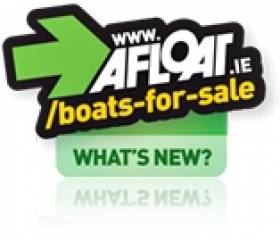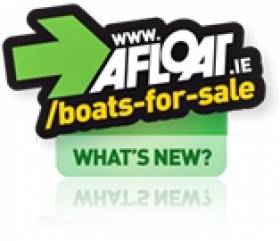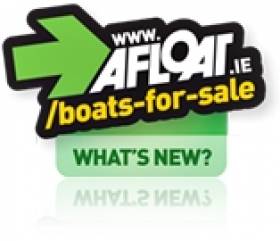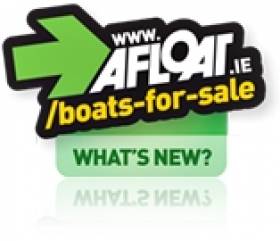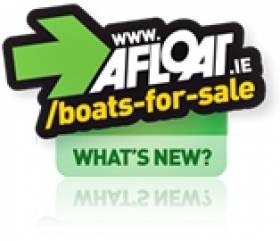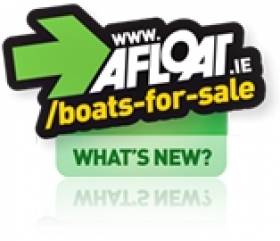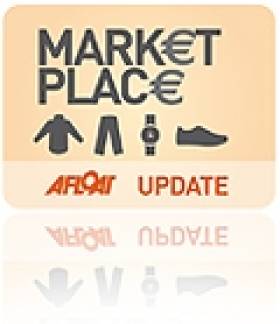Displaying items by tag: boats for sale
Shallow Draft Dufour 325 Goes on Sale for €72,500
#BOATS FOR SALE – A 2006 Dufour 325 Grand'Large "Limited Edition Arpege" with one owner from new has come on the market from Crosshaven Boatyard. According to the Cork broker the French yacht been well looked after. She is the shallow draft keel (1.5M) version. "Molia" comes with a 19hp Volvo engine, 6 berths, furling headsail, wheel steering, electric windlass, teak cockpit seats and much more. For more details, photos and a download spec on the Afloat Boats for Sale site click here
Ocean Going Family Yacht is 'Reluctantly' For Sale
#BOATS FOR SALE – A 47-year-old 35-footer 'Dotty Dee' is a reluctant sale after being part of a family for 16 year. This Sparkman & Stevens designed Chris Craft yacht was built in 1965 and is on the market through Crosshaven Boatyard. Dotty Dee has taken her present owners safely on a number of ocean crossings and thousands of miles. Her semi-enclosed centre cockpit gives excellent protection from the elements. She comes with a good specification and is worth a look here
Elan 340 for Sale (That Can Pay Her Running Costs!)
#BOATS FOR SALE – A 'highly spec'd and well maintained' 2007 Elan 340 has just come on the market. According to the broker Crosshaven Boatyard in Cork 'the yacht has the unique advantage of earning an income for her new owners'.
Priced at €73,500 ex VAT, this hi-tech designed performance cruiser has been used as a sail training and charter yacht with Kinsale's Sovereign Sailing. James Lyons from Sovereign Sailing told Afloat.ie "The Elan is a perfect fit for our fleet as she is licensed by the DOT for skippered and bareboat charter. The concept of our management fleet is the that owners use the boat as much as they wish and we use it for around 6-8 weeks a year which covers all her annual expenses".
She can be viewed through Hugh Mockler of Crosshaven Boat Yard. The full advert giving detailed specs is on the Afloat Boats for Sale site HERE.
Further Price Reduction on 2006 Dufour 385
#BOATS FOR SALE – A 'lightly used' Dufour 385 built in 2006 has been further reduced by €15,500 and is now available at €99,000. The family cruiser is described online as 'solid and well equipped'. The yacht, which can be seen at Crosshaven boatyard, Cork comes with an upgraded engine (40HP Volvo). The yacht has twin wheels and an In-mast furling mainsail. The full advert giving detailed specs is on the Afloat Boats for Sale site.
Mediterranean Based Beneteau on the Market
#BOATS FOR SALE – A 2001 single–owner model of one of Beneteau's most popular cruising yachts is on the market priced €115,000 on the Afloat Boats for Sale site.
This Beneteau Oceanis 411 is already located for Mediterranean cruising, based in MDL Marina's new facility in Sant Carles de la Rapita, an hour's drive south from Barcelona's Reus airport. If required, her berth in Sant Carles is ready to transfer to her new owner, according to the advert.

Sunny side of life: The Beneteau Oceanis 411 on her Mediterranean berth
Relatively little used in her ten years, the owner says she is fitted throughout for comfortable and safe cruising. The full details are here.
Sabre 426 and Beneteau Idylle 1350 Go On Sale
#BOATS FOR SALE – Two 40-foot sailing cruisers have gone on sale on the Afloat boats for sale site today one priced at €249,500 and the other at €74,950. They're on sale through popular Cork broker Crosshaven Boatyard who currently has 63 yachts on offer on the boats for sale site.
The €249,000 boat is the American built Sabre 426. Built in 2004 and commissioned in 2005, this Sabre 426 is a moderate displacement cruising yacht with 'excellent performance' according ot the broker. The boat comes with cherry interior, two heads, 55HP Yanmar, Bow Thruster, 2010 fully battened mainsail, plotter, radar and heating. There has only been one owner since new.
Sabre's attention to detail as a boat builder is well known. Whether it be the style and grace of the 426's shear, the details of the deck tooling or the details found in the hand crafted interior joinery. The full advert is here.
The €74,950 yacht is a 1987 German Frers designed Beneteau Idylle 13.50. This boat has also had one owner since new. This yacht sleeps seven and has been well maintained. She had a major refit in 2010/2011, including a new engine, standing rigging and sails. All the details here.
'Low Usage' Beneteau Oceanis 311 Clipper up for Sale
#BOATSFORSALE – A very low usage and exceptionally well maintained family cruiser that 'wants for nothing' is for sale on the Afloat Boats for Sale site. The 1999 Beneteau Oceanis 311 Clipper has an inmast furling main and furling headsail. Below decks the forecabin has double berth and an Eberspacher warm air heating vented to main cabin and aft double (new 2009). The boat has been wintered ashore Dun Laoghaire every winter according to the seller. A substantial cradle is available as an extra. More details on the boat here.
Smart Tips for Practical Boat Buying
#BUYING A BOAT - With all the excitement that comes with buying a new boat, there are a number of important factors that every prospective purchaser should keep in mind, according to website Mad About Yachts.
First and foremost, any decision to buy a boat must be based on your specific requirements and your available finances. It's easy to get carried away with the idea of owning a large size boat, but it's pointess if you can't affort the time or resources to maintain such a valuable asset.
Figure out first what you want and need the boat for, then from that work out your estimated running costs - which include not only maintenance but also mooring and club fees. This will give you a good guideline to narrow down your options before you venture into the marketplace.
Always bear in mind that "one kind of sailing vessel cannot be the perfect choice for all kinds of water based activities".
Mad About Yachts has more advice for boat buyers HERE. And don't forget to check out Afloat's dedicated Boats for Sale site for the latest deals.
Tony Castro 3/4 Tonner is New on Afloat Boats for Sale
#BOATS FOR SALE – New to our Boats for Sale site is this Tony Castro 3/4 Tonner. "Strictly Business" is a one off Tony Castro 3/4 Ton design. She was built in 1988 and named "Bateleur 88" and was successfully campaigned by her then owner Chris Bonnar. Click here for the full listing including images and full spec and extras.
Our Boats for Sale website has been updated. We've listened to the needs of you, the buyers and sellers to bring you the site Ireland needs for boat trading.
Firstly, our aim is to generate Ireland's largest stock of quality boats for sale, in order to do this we've introduced a modest charge of €10 to list your boat for 60 days. We've simplified the steps involved to advertise your boat, and once you've walked through them here are some of the advantages your boat has to gain maximum exposure...
- Our aim is to offer Ireland's largest range of quality boats for sale.
- With upwards of 3,000 visitors per day and 70% of traffic from search engine queries, Afloat.ie is the number one boating portal site in Ireland.
- Your boat will be added to Ireland's largest boating mailing list with over 10,000 subscribers, giving your boat more exposure both at home and abroad
- There's tips too for buyers and sellers covering choosing a boat, asessing value, financing a boat, advertising a boat for sale and the necessary paperwork.
- Our aim is to provide an independent quality alternative where Irish boat buyer can meet Irish boat seller at a cost-effective price.
Jeanneau Merry Fisher is New On Afloat Boats For Sale
New to our Boats for Sale site is a Jeanneau Merry Fisher 805 Cruiser. Two cabin 4 berth with "v" berth forward. Volvo 200 HP with low hours and service record. Winter stored ashore. click here for the full listing including images and full spec and extras.
Our Boats for Sale website has been updated. We've listened to the needs of you, the buyers and sellers to bring you the site Ireland needs for boat trading.
Firstly, our aim is to generate Ireland's largest stock of quality boats for sale, in order to do this we've introduced a modest charge of €10 to list your boat for 60 days. We've simplified the steps involved to advertise your boat, and once you've walked through them here are some of the advantages your boat has to gain maximum exposure...
- Our aim is to offer Ireland's largest range of quality boats for sale.
- With upwards of 3,000 visitors per day and 70% of traffic from search engine queries, Afloat.ie is the number one boating portal site in Ireland.
- Your boat will be added to Ireland's largest boating mailing list with over 10,000 subscribers, giving your boat more exposure both at home and abroad
- There's tips too for buyers and sellers covering choosing a boat, asessing value, financing a boat, advertising a boat for sale and the necessary paperwork.
- Our aim is to provide an independent quality alternative where Irish boat buyer can meet Irish boat seller at a cost-effective price.


























